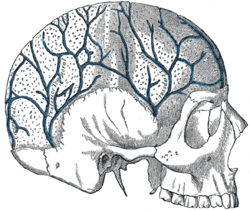- Diploë
-
Diploë 
Veins of the diploë as displayed by the removal of the outer table of the skull. Latin canales diploici Gray's subject #17 80 Vein diploic veins Diploë refers to the spongy bone structure (or tissue) of the internal part of short, irregular, and flat bones.
In the cranial bones, the layers of compact tissue are familiarly known as the tables of the skull; the outer one is thick and tough; the inner is thin, dense, and brittle, and hence is termed the vitreous table. The intervening cancellous tissue is called the diploë, and this, in certain regions of the skull, becomes absorbed so as to leave spaces filled with liquid between the two tables.
The diploe houses and protects the red bone marrow only found in hip bones, ribs, sternum, vertebrae, and ends of long bones, in adults. Its fluid-filled spaces reduce the weight of most bones, allowing them to be more easily moved and supported by skeletal muscles. It is similar to the medullary cavity in long bones.
External links
This article was originally based on an entry from a public domain edition of Gray's Anatomy. As such, some of the information contained within it may be outdated.
Bones of head and neck: compound structures of skull (TA A02.1.00.002–052, GA 2.178–199) Neurocranium Calvaria (Diploë)
Asterion · Pterion · Stephanion · Bregma · Lambda
Fossae: anterior cranial fossa · middle cranial fossa · posterior cranial fossa · cranial cavity
Base of skull
Fontanelles: anterior · posterior · sphenoidal · mastoidFacial skeleton Both Categories:- Musculoskeletal system stubs
- Skull
Wikimedia Foundation. 2010.
